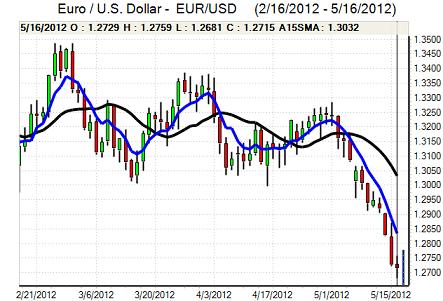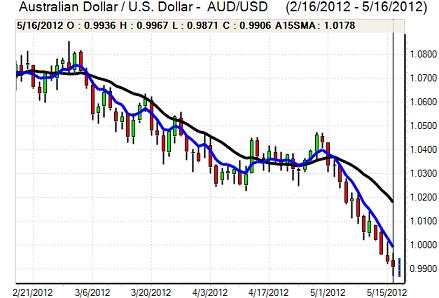EUR/USD
The Euro found some support below 1.27 against the dollar in Europe on Wednesday and attempted a corrective recovery, although the main feature was a further increase in volatility.
There were further market fears surrounding the Greek situation with continuing speculation over the threat of a Euro-zone exit with confirmation that new elections will be held on 17th June. The Greek President appointed a senior judge as interim Prime Minister ahead of the polls.
During the day, there was speculation that the ECB was looking to hold an emergency meeting and there were also reports that the ECB was set to suspend lending to some Greek banks until they had boosted their capital reserves. There were wider fears surrounding the Greek banking sector on expectations that deposit withdrawals were continuing and rumours that cash withdrawals would be limited. There appeared to be confirmation that the ECB had stopped providing liquidity to some Greek banks.
In this environment, there were further fears surrounding the wider Euro-zone financial sector and there were also substantive fears surrounding a contagion threat if there was a Greek Euro-zone exit.
There was increased pressure for ECB action to help stabilise bond markets and there was also speculation of an additional LTRO which helped lower yields and pull the Euro off its lows.
The US housing starts data was stronger than expected with an increase to an annual rate of 0.72mn for April from 0.70mn previously while permits fell to 0.72mn from 0.77mn, but they were still at the highest level since 2008. A stronger than expected increase in industrial production was offset by a downward revision for the previous month.
The Fed minutes confirmed that the FOMC was more optimistic surrounding the growth outlook with the probability of a slow decline in unemployment. Several members did indicate that further monetary accommodation could be required if the economy lost momentum. The Fed also expressed concerns surrounding the fiscal outlook which reminded markets over the underlying risks and there will be increased speculation over quantitative easing if there are further Euro losses. Euro rallies stalled in the 1.2750 region against the dollar in choppy trading conditions.

Source: VantagePoint Intermarket Analysis Software
Call now and you will be provided with FREE recent forecasts
that are up to 86% accurate* 800-732-5407
If you would rather have the recent forecasts sent to you, please go here
Yen
The dollar was unable to break above the 80.50 region against the yen on Wednesday and drifted lower during the US session. The yen tested resistance levels below 102 against the Euro and gained wider support from a deterioration in risk appetite, although the currency was still unable to gain sustained support during the session.
There was further speculation that the Finance Ministry could intervene to weaken the currency which curbed buying interest. The latest Japanese GDP data recorded a quarterly increase of 1.0% which was slightly stronger than expected and the previous release was revised to unchanged from an original -0.6%. The dollar consolidated in the 80.30 region against the yen in Asia as regional equity markets looked to stabilise.
Sterling
The latest UK unemployment data was stronger than expected with a decline in the claimant count of 13,700 for April following a revised decline the previous month while the unemployment rate declined to 8.2% from 8.3% previously, although the drop was fuelled primarily by an increase in part-time employment.
In its quarterly inflation report, the Bank of England lowered its growth and inflation forecasts for the two-year outlook. The main focus on the report tended to be the bank’s news conference with Governor King stating that there were substantial uncertainties and risks resulting from the Euro-zone crisis. With a lowering of inflation forecasts and warning over the Euro area, there was additional speculation that the central bank would sanction additional quantitative easing over the next 2-3 months, especially if Euro-zone conditions deteriorated further.
Although Sterling dipped to lows below 1.59 against the dollar, it was still able to secure defensive support as benchmark yields fell to record lows and consolidated just above this level.
Swiss franc
The dollar hit resistance above 0.9450 against the franc on Wednesday and retreated back towards 0.94 before gaining fresh support as the Euro remained pinned to the 1.2010 level against the Swiss currency.
The Swiss ZEW business confidence index fell to -4.0 from 2.1 the previous month which maintained unease over the growth outlook.
There was further speculation that capital flight from the Euro-zone would put additional pressure on the 1.20 minimum Euro level and force more aggressive National Bank intervention to prevent franc gains.

Source: VantagePoint Intermarket Analysis Software
Call now and you will be provided with FREE recent forecasts
that are up to 86% accurate* 800-732-5407
If you would rather have the recent forecasts sent to you, please go here
Australian dollar
The Australian dollar found some degree of support below the 0.99 level against the US currency and recovered to highs just above the 0.9950 level before selling pressure resumed.
The Australian currency was again hampered by a deterioration in risk appetite as equity markets remained on the defensive. There was some relief when European peripheral bond yields declined from intra-day peaks and equity markets also held slightly firmer in Asia on Thursday which helped limit Australian dollar selling.



